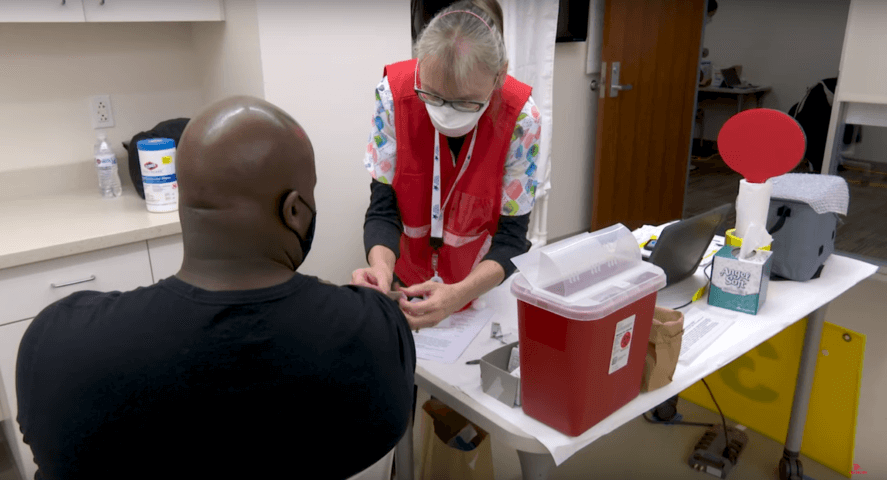
An Arlington County Vaccination Pod nurse administers a band-aid after a patient receives a COVID-19 vaccine. Contributed photo.
As the Commonwealth is still under 70% vaccinated, state officials shift to personalized care.
DANVILLE – The former JCPenney store at the Danville Mall turned into a mass vaccination site earlier this year. Designed to administer up to 3,000 COVID-19 vaccine doses a day, the site closed during the first week of May.
Just up the road in the town of Gretna, located in neighboring Pittsylvania County, a mass vaccination site opened in April. By the end of May, the clinic ceased to exist – a month sooner than contracted.
So why are the mass vaccination clinics disappearing with only 44.6% of Virginia’s population fully vaccinated? Besides, that’s still a ways from the 70% herd immunity goal.
According to Dr. Danny Avula, state vaccine coordinator, it was time for a shift. While he noted that some communities continue utilizing their vaccination centers in creative ways, they are no longer the central focus for the vaccine rollout.
“So much of our work has continued to make that shift away from the large scale mass vaccination efforts,” Avula said.
A new vaccination focus rests on three main areas in the state: primary care providers, pharmacies and mobile units.
Primary Care Providers have Vaccines
As more COVID vaccine became available, primary care providers received doses. Some recent changes involving the Pfizer vaccine made vaccine opportunities more realistic for some primary care providers.
The federal government recently made a significant change concerning the number of Pfizer vaccines available in a single shipment. Rather than trays of 1,170 doses being the only allocation available, some shipments lessened to 450 doses.
“So they’re doing some work on their end to make that easier,” Avula said. “But we still have providers who really only want 30 doses or 50 doses or 100 doses at a time.”
Pfizer also recently updated its guidance on storage requirements for the COVID-19 vaccine. That made stockpiling the vaccine more manageable for some practices that otherwise had limited storage availability options.
“Instead of having a really limited amount of time that Pfizer could be refrigerated, we can now ship things frozen, have them frozen for two weeks, and then have a full month at refrigeration temperatures,” Avula said. “And so that’s going to make it a lot easier for many practices to receive Pfizer – to keep it frozen and transition it to [the] refrigerator and have a lot more time to work through those doses.”
Avula further noted that the shift to primary care vaccination opportunities arose due to “segments of our community who just want reassurance, want to talk to a healthcare provider.”
Pharmacies Continue Pandemic Practices
At the start of the COVID-19 vaccination allocation in December, CVS Health was one of the first places to get vials.
Across the state, a total of 36 CVS pharmacies participated in the initial rollout. They focused on vaccinating residents in long-term care facilities, as well as the healthcare workers that provided their care.
Of the approximately 15,000 skilled nursing facilities nationwide, nearly 8,000 partnered with CVS Health in December. An additional 31,000 assisted living facilities also took advantage of the partnership.
Throughout the winter, the program expanded to also include Walgreens and Managed Health Care Associates, Inc.
By late February, the Pharmacy Partnership for Long-Term Care Program facilitated on-site vaccination of residents and staff at more than 63,000 enrolled long-term care facilities.
Also in February, CVS started offering the COVID vaccine to eligible populations. By April 1, CVS Health surpassed 10 million COVID-19 vaccine doses administered through its participation in the Pharmacy Partnership for Long-Term Care Program and Federal Retail Pharmacy Program.
As vaccination allocations steadily increased over the spring, smaller pharmacies also received doses. That’s a trend that will likely remain steady in the coming weeks, especially given the lessened amount of vaccine per shipment.
“We’re going to continue to build out our network of independent pharmacies and hubs that can receive those shipments, break them down and redistribute them to providers so that they can have a manageable amount,” Avula said.
The Move to Mobile
In addition to primary care providers and individual pharmacies, there’s another project.
“We are also shifting more to the mobile units and the targeted efforts, the popup clinics,” Avula said. “And so while those [vaccination rate] numbers are harder to come by, we’re certainly seeing a lot of fruit. It’s just slower and it’s harder. And that’s going to be the case for the next three to four months.”
Mobile vaccine clinics popped up pretty quickly in late January. That came after the Biden administration put out the National Strategy for the COVID-19 Response and Pandemic Preparedness. The manuscript called for the federal government — in partnership with state and local governments — to create as many venues for vaccination as needed in communities and settings that people trusted. One of the suggested venues was a mobile vaccine clinic.
“The [Biden] administration will deploy mobile clinics to meet communities where they are, and also to offer vaccines in the most hard-to-reach communities, working with local providers, including primary care providers, to ensure that they have the resources they need to help get vaccines to the communities they serve,” the strategy read in part.
No More Mass Vaccination Sites
As mobile vaccine units roll out across the state, the number of units on the road any given day varies.
The Virginia Department of Health does not keep an exact count of mobile units pertaining to each district. However, the practices for each unit remain standard.
“Vaccine is not being provided within the vehicle itself,” said Melissa Gordon, a VDH public information officer. “It is being administered either in an outside venue – [a] tent or covered area – or within a community facility.”
Mobile units through the VDH vaccinate people at both small and large-scale events, as well as home-bound individuals.
“We have several different types of mobile units currently in play. Some health districts have their own. Some are partnering with other organizations to offer mobile clinics. And then VDH is offering mobile vaccination clinics in the Western, Central and Eastern regions,” Gordon said.
She added that VDH is scheduling one to two clinics per day, while the number run by local districts constantly changes, based on need.
Getting the Vaccine to the People
The Virginia Department of Health’s Central Virginia Health District, in coordination with the VDEM and other supporting partners, recently announced its first mobile Johnson & Johnson vaccination clinic. The event will take place Saturday from 1 to 6 p.m. at Highland Center in Monterey.
“CSHD is excited to partner with VDEM to offer these mobile COVID-19 vaccine clinics,” said Dr. Laura Kornegay, director of the Central Shenandoah Health District. “We encourage unvaccinated people to take advantage of these convenient clinics that will increase vaccine access in the hollers of our rural communities.”
The Central Virginia Health District also utilized mobile vaccine units as part of its COVID response.
“We’re pleased to be able to offer more vaccination opportunities for the people in our health district,” said Dr. Kerry Gateley, Central Virginia Health District director. “As evidence for the safety and effectiveness of the vaccines grows all around us, we know that people who haven’t been vaccinated yet will be looking for opportunities to gain immunity to COVID-19.”
Amie Knowles reports for Dogwood. You can reach her at [email protected]
JOIN THE CONVERSATION: Sign Up For Dogwood’s Newsletter
Politics

VIDEO: Domestic abuse victims speak out against the gun law bills Gov. Glenn Youngkin vetoed
Senate Bill 47 and House Bill 46 aim to close the loophole that allows offenders to transfer their firearms to someone else instead of relinquishing...

Virginia Beach nurse: Rep. Kiggans should stand with patients, protect the ACA
With almost 350,000 Virginians relying on the Affordable Care Act for their health insurance, it is critical that Virginians know their members of...
Local News

Virginia verses: Celebrating 5 poetic icons for National Poetry Month
There’s no shortage of great writers when it comes to our commonwealth. From the haunting verses of Edgar Allan Poe, who found solace in Richmond's...

Join the fun: Recapping Family Literacy Night’s storybook adventures
When’s the last time you read a book aloud with a loved one? If it’s difficult to answer that question, then maybe it’s time to dust off that TBR...





